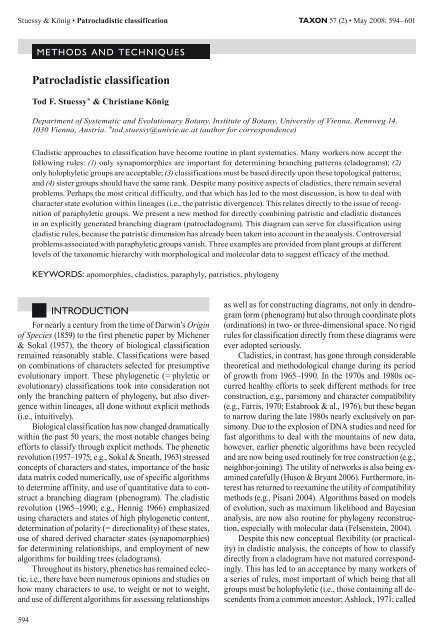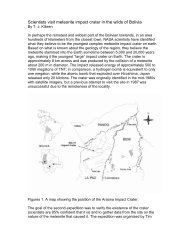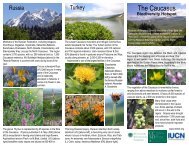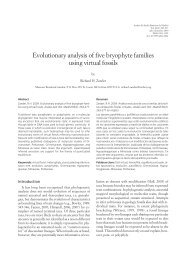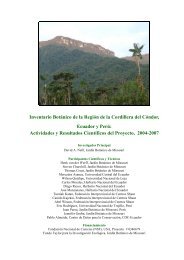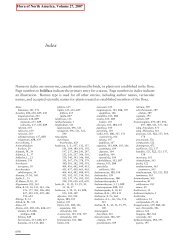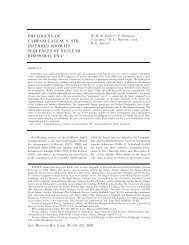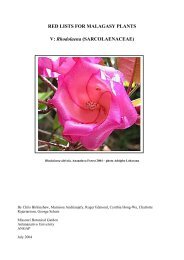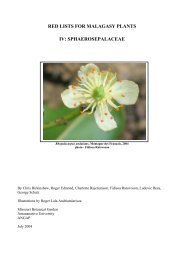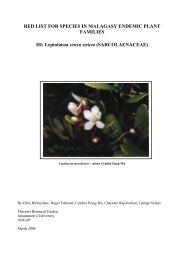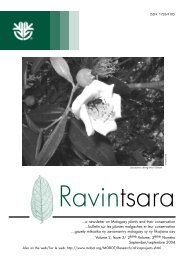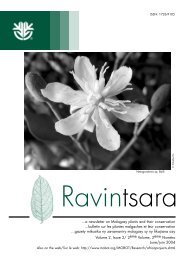Taxon 57: 594
Taxon 57: 594
Taxon 57: 594
Create successful ePaper yourself
Turn your PDF publications into a flip-book with our unique Google optimized e-Paper software.
Stuessy & König • Patrocladistic classification<br />
<strong>594</strong><br />
METHODS AND TECHNIQUES<br />
Patrocladistic classification<br />
Tod F. Stuessy * & Christiane König<br />
INTRODUCTION<br />
For nearly a century from the time of Darwin’s Origin<br />
of Species (1859) to the first phenetic paper by Michener<br />
& Sokal (19<strong>57</strong>), the theory of biological classification<br />
remained reasonably stable. Classifications were based<br />
on combinations of characters selected for presumptive<br />
evolutionary import. These phylogenetic ( = phyletic or<br />
evolutionary) classifications took into consideration not<br />
only the branching pattern of phylogeny, but also divergence<br />
within lineages, all done without explicit methods<br />
(i.e., intuitively).<br />
Biological classification has now changed dramatically<br />
within the past 50 years, the most notable changes being<br />
efforts to classify through explicit methods. The phenetic<br />
revolution (19<strong>57</strong>–1975; e.g., Sokal & Sneath, 1963) stressed<br />
concepts of characters and states, importance of the basic<br />
data matrix coded numerically, use of specific algorithms<br />
to determine affinity, and use of quantitative data to construct<br />
a branching diagram (phenogram). The cladistic<br />
revolution (1965–1990; e.g., Hennig 1966) emphasized<br />
using characters and states of high phylogenetic content,<br />
determination of polarity ( = directionality) of these states,<br />
use of shared derived character states (synapomorphies)<br />
for determining relationships, and employment of new<br />
algorithms for building trees (cladograms).<br />
Throughout its history, phenetics has remained eclectic,<br />
i.e., there have been numerous opinions and studies on<br />
how many characters to use, to weight or not to weight,<br />
and use of different algorithms for assessing relationships<br />
TAXON <strong>57</strong> (2) • May 2008: <strong>594</strong>–601<br />
Department of Systematic and Evolutionary Botany, Institute of Botany, University of Vienna, Rennweg 14,<br />
1030 Vienna, Austria. *tod.stuessy@univie.ac.at (author for correspondence)<br />
Cladistic approaches to classification have become routine in plant systematics. Many workers now accept the<br />
following rules: (1) only synapomorphies are important for determining branching patterns (cladograms); (2)<br />
only holophyletic groups are acceptable; (3) classifications must be based directly upon these topological patterns;<br />
and (4) sister groups should have the same rank. Despite many positive aspects of cladistics, there remain several<br />
problems. Perhaps the most critical difficulty, and that which has led to the most discussion, is how to deal with<br />
character state evolution within lineages (i.e., the patristic divergence). This relates directly to the issue of recognition<br />
of paraphyletic groups. We present a new method for directly combining patristic and cladistic distances<br />
in an explicitly generated branching diagram (patrocladogram). This diagram can serve for classification using<br />
cladistic rules, because the patristic dimension has already been taken into account in the analysis. Controversial<br />
problems associated with paraphyletic groups vanish. Three examples are provided from plant groups at different<br />
levels of the taxonomic hierarchy with morphological and molecular data to suggest efficacy of the method.<br />
KEYWORDS: apomorphies, cladistics, paraphyly, patristics, phylogeny<br />
as well as for constructing diagrams, not only in dendrogram<br />
form (phenogram) but also through coordinate plots<br />
(ordinations) in two- or three-dimensional space. No rigid<br />
rules for classification directly from these diagrams were<br />
ever adopted seriously.<br />
Cladistics, in contrast, has gone through considerable<br />
theoretical and methodological change during its period<br />
of growth from 1965–1990. In the 1970s and 1980s occurred<br />
healthy efforts to seek different methods for tree<br />
construction, e.g., parsimony and character compatibility<br />
(e.g., Farris, 1970; Estabrook & al., 1976), but these began<br />
to narrow during the late 1980s nearly exclusively on parsimony.<br />
Due to the explosion of DNA studies and need for<br />
fast algorithms to deal with the mountains of new data,<br />
however, earlier phenetic algorithms have been recycled<br />
and are now being used routinely for tree construction (e.g.,<br />
neighbor-joining). The utility of networks is also being examined<br />
carefully (Huson & Bryant 2006). Furthermore, interest<br />
has returned to reexamine the utility of compatibility<br />
methods (e.g., Pisani 2004). Algorithms based on models<br />
of evolution, such as maximum likelihood and Bayesian<br />
analysis, are now also routine for phylogeny reconstruction,<br />
especially with molecular data (Felsenstein, 2004).<br />
Despite this new conceptual flexibility (or practicality)<br />
in cladistic analysis, the concepts of how to classify<br />
directly from a cladogram have not matured correspondingly.<br />
This has led to an acceptance by many workers of<br />
a series of rules, most important of which being that all<br />
groups must be holophyletic (i.e., those containing all descendents<br />
from a common ancestor; Ashlock, 1971; called
TAXON <strong>57</strong> (2) • May 2008: <strong>594</strong>–601<br />
monophyletic by most workers). Paraphyletic groups, i.e.,<br />
those that come from a common ancestor but do not contain<br />
all descendents (i.e., traditional definition of monophyly),<br />
are regarded as unacceptable.<br />
The issue of whether or not to accept paraphyletic<br />
groups remains a central problem of biological classification<br />
(Nordal & Stedje, 2005; Williams & al., 2005; Hörandl,<br />
2006). Although there are many evolutionary aspects to<br />
consider (Hörandl, 2007), the crux of the problem lies with<br />
character divergence within lineages, which strict cladistic<br />
classification does not take into account. We propose here<br />
a method of incorporating patristic distances, or evolutionary<br />
divergence within lineages, into an explicit method of<br />
producing a branching diagram (called a patrocladistic tree<br />
or patrocladogram). This dendrogram, because it already<br />
contains a measure of the patristic relationships among the<br />
taxa under study, can be used directly in classification by<br />
applying strict cladistic rules (especially the holophyletic<br />
criterion). We view this as most suitable for employment in<br />
groups that have obviously divergent members as revealed<br />
by tree construction (also often with conspicuous obvious<br />
morphological divergence). This should eliminate, or at<br />
least significantly reduce, the controversy over how to deal<br />
with paraphyletic groups. Discussion will rather shift to the<br />
characters and states involved with patristic distance and<br />
their relative weighting against synapomorphic character<br />
states. Such discussions on which characters and weights<br />
provide the best classifications are certainly not new in<br />
biological systematics and will doubtless never be resolved<br />
completely.<br />
MATERIALS AND METHODS<br />
The basis for patrocladistic classification is to first<br />
complete a cladistic analysis via any specific algorithm<br />
(parsimony, compatibility, Bayesian probability, maximum<br />
likelihood). Essential is to generate one selected tree, based<br />
on whatever support criteria, upon which to optimize the<br />
characters and states from the original data matrix. The<br />
distribution of apomorphies on the cladogram would usually<br />
be derived from the same analysis, but it would not<br />
have to be the case (apomorphies could be optimized on<br />
a neighbor-joining tree, for example). This is an important<br />
step, obviously, because different trees have different<br />
numbers of apomorphies that support the branches. The<br />
worker must decide which tree-building algorithm is more<br />
appropriate in the context of the particular group under<br />
investigation. Some trees will result in more homoplasious<br />
apomorphies than others, and this will obviously impact<br />
calculation of the patristic distances. Support levels should<br />
obviously also be high, as well as complete taxon sampling,<br />
as is the case with any attempt to derive a classification<br />
from a branching tree. This cladogram then serves as a<br />
Stuessy & König • Patrocladistic classification<br />
structure for modification based on patristic distance. Cladistic<br />
distances are calculated from the selected cladogram,<br />
and these are defined as the number of nodes that separate<br />
two taxa. These values are placed in a new cladistic matrix<br />
and are the basis for modification by addition of patristic<br />
distances. The patristic distance is defined as the number<br />
of apomorphic step changes separating two taxa on the cladogram.<br />
Unless only single synapomorphies define nodes<br />
in the cladistic analysis, the patristic distance will normally<br />
be larger than the cladistic distance. The patristic distance<br />
is then added to the cladistic distance to form the combined<br />
patrocladistic data matrix. These combined distances are<br />
used as input into a tree-building algorithm (or other phenetic<br />
methods such as UPGMA, single-linkage, etc.) for<br />
derivation of a modified branching pattern (the patrocladogram).<br />
We have used single-linkage in this paper because<br />
it more quickly connects groups and also more distinctly<br />
reveals dendrogram structure. Obviously, the greater the<br />
patristic distance within lineages, the more topological<br />
impact it will have on the patrocladogram. This new diagram,<br />
then, can be used in an explicit cladistic holophyletic<br />
(monophyletic) evaluation for classification.<br />
Because the patristic distances will usually be larger<br />
than those from the cladistic pattern, they can be scaled and/<br />
or weighted (or deweighted) accordingly. For purposes of<br />
illustration, we have here transformed both cladistic and patristic<br />
distances to a scale between 0 and 1. Depending upon<br />
the evolutionary convictions of the particular worker, these<br />
values can also then be uniformly adjusted for their impact<br />
on the resultant topology. If the patristic distances were<br />
maintained and the cladistic distances reduced to nearly<br />
zero, the resulting diagram would approximate a phenogram,<br />
except that the characters were initially selected for<br />
their phylogenetic import (which is not usually the case<br />
with phenetics). How to weight the patristic vs. cladistic<br />
distances correctly in a theoretical context is not yet known.<br />
This must be assessed through tests of information content<br />
(and theory), which have rarely been applied to units of<br />
classification except in a strict cladistic context (e.g., Farris,<br />
1979; see, however, also early broader steps in this direction<br />
by Duncan & Estabrook, 1976, and Carpenter, 1993).<br />
To demonstrate the efficacy of the method, three examples<br />
are presented, two using morphological and one<br />
employing DNA sequence data. The first deals with the<br />
genera Ammobium and Nablomium of Asteraceae (tribe<br />
Inuleae), which have been classified by Anderberg (1990,<br />
1992). This represents a case of extreme divergence within<br />
a single lineage. The second deals with the traditionally<br />
recognized temperate families, Hippocastanaceae and<br />
Aceraceae, and their relationships to the tropical Sapindaceae<br />
based on morphological data (Judd & al., 1994).<br />
The third and final case is placement of the family Lactoridaceae<br />
relative to Aristolochiaceae and Piperales based<br />
on DNA sequence data (Qiu & al., 1999). Other molecular<br />
595
Stuessy & König • Patrocladistic classification<br />
datasets exist regarding relationships of Lactoridaceae<br />
(e.g., Qiu & al., 2005), but this is not pertinent in terms<br />
of presenting the method here. The three examples were<br />
chosen to demonstrate the utility of directly incorporating<br />
patristic evolutionary distance into a dendrogram that then<br />
forms the basis for classification, and to do so by use of<br />
both morphological as well as molecular data. The cladistic<br />
and patristic distances derived from these original<br />
papers are presented in Tables 1–3.<br />
RESULTS<br />
In the case of the Ammobium-Nablonium example<br />
(Figs. 1–2), it is obvious that incorporation of the patristic<br />
distance will have a large effect on the resultant den-<br />
Table 1. Matrix of cladistic (lower left) and patristic (upper<br />
right) distances among taxa of Ammobium and Nablonium.<br />
A. cras- N. caly-<br />
A. alatum pedioidesceroides A. alatum 5 24<br />
A. craspedioides 2 19<br />
N. calyceroides 2 1<br />
Based on original data in Anderberg (1990).<br />
596<br />
TAXON <strong>57</strong> (2) • May 2008: <strong>594</strong>–601<br />
drogram. There is, in fact, more evolutionary character<br />
divergence (apomorphy) in the terminal lineage leading<br />
to Nablonium than within the rest of the entire cladogram<br />
(Fig. 1). Not surprisingly, with addition of patristic<br />
distance, the explicitly derived dendrogram changes<br />
(Fig. 2), whereby now the genus Nablonium is again supported<br />
by the patrocladistic topology. Both genera are<br />
now holophyletic. Orchard (1992) specifically argued for<br />
this viewpoint. For those workers wishing to incorporate<br />
divergence within lineages in their classifications, this<br />
simple example shows how it can be done quantitatively.<br />
Hippocastanaceae and Aceraceae, both relatives of<br />
larger Sapindaceae, represent a more complex example<br />
based on morphological data. As is well known, the former<br />
two temperate families have long been recognized (e.g.,<br />
Cronquist, 1981; Takhtajan, 1997). Judd & al. (1994), based<br />
on cladistic analyses of morphological features, presented<br />
a cladogram (Fig. 3) that shows clearly the distribution of<br />
the two families relative to the more inclusive and tropical<br />
Sapindaceae. Because recognition of Hippocastanaceae and<br />
Aceraceae as families would render Sapindaceae paraphyletic,<br />
all have been placed in Sapindaceae (see also Judd &<br />
al., 2002). As can be seen from the cladogram, however,<br />
numerous morphological synapomorphies define each of<br />
the two smaller families. A patrocladistic analysis of the<br />
morphological data reveals (Fig. 4) that with unweighted<br />
Table 2. Matrix of cladistic (lower left) and patristic (upper right) distances among genera of Sapindales.<br />
Genera<br />
Genera 1 2 3 4 5 6 7 8 9 10 11 12 13 14 15 16 17 18 19<br />
Hypelate (1) 18 18 18 13 14 8 8 13 10 13 17 17 20 21 23 23 29 29<br />
Aesculus (2) 5 2 4 19 20 14 20 25 22 25 29 29 32 33 35 35 41 41<br />
Billia (3) 5 1 4 19 20 14 20 25 22 25 29 29 32 33 35 35 41 41<br />
Handeliodendron (4) 4 2 2 19 20 14 20 25 22 25 29 29 32 33 35 35 41 41<br />
Delevaya (5) 5 5 5 4 7 5 15 20 17 20 24 24 27 28 30 30 36 36<br />
Ungnadia (6) 5 5 5 4 1 6 16 21 18 21 25 25 28 29 31 31 37 37<br />
Koelreuteria (7) 4 4 4 3 2 2 10 15 12 15 19 19 22 23 25 25 31 31<br />
Talisia (8) 3 5 5 4 5 5 4 7 4 7 11 11 14 15 17 17 23 23<br />
Euphoria (9) 4 6 6 5 6 6 5 2 5 8 12 12 15 16 18 18 24 24<br />
Sapindus (10) 5 7 7 6 7 7 6 3 2 3 7 7 10 11 13 13 19 19<br />
Cupania (11) 6 8 8 7 8 8 7 4 3 2 6 6 9 10 12 12 18 18<br />
Thinonia (12) 7 9 9 8 9 9 8 5 4 3 2 4 7 8 10 10 16 16<br />
Thouinia (13) 8 10 10 9 10 10 9 6 5 4 3 2 5 6 8 8 14 14<br />
Athayana (14) 9 11 11 10 11 11 10 7 6 5 4 3 2 5 7 7 13 13<br />
Serjania (15) 10 12 12 11 12 12 11 8 7 6 5 4 3 2 6 6 12 12<br />
Bridgesia (16) 11 13 13 12 13 13 12 9 8 7 6 5 4 3 2 4 10 10<br />
Diatenopteryx (17) 12 14 14 13 14 14 13 10 9 8 7 6 5 4 3 2 8 8<br />
Dipteronia (18) 13 15 15 14 15 15 14 11 10 9 8 7 6 5 4 3 2 2<br />
Acer (19) 13 15 15 14 15 15 14 11 10 9 8 7 6 5 4 3 2 1<br />
Based on original data in Judd & al. (1994); order of genera following their cladogram.
TAXON <strong>57</strong> (2) • May 2008: <strong>594</strong>–601<br />
patristic data, both groups separate considerably, with Hippocastanaceae<br />
(including Handeliodendron) becoming the<br />
sister group of all the rest. Aceraceae, however, remain<br />
embedded within Sapindales, a position favored by Chase<br />
& al. (2000). It is also worth mentioning that based on molecular<br />
data the recognition of these two temperate families<br />
remains unresolved (Gadek & al., 1996).<br />
The final example concerns the very interesting ancient<br />
family Lactoridaceae (for a review of features see Stuessy<br />
& al., 1998). This is a monospecific family (with L. fernandeziana)<br />
confined today to the Juan Fernandez (Robinson<br />
Crusoe) islands in the eastern Pacific Ocean off the coast<br />
of Chile. Although presently restricted to Masatierra Island,<br />
known radiometrically at c. 4 million years of age<br />
(Stuessy & al., 1984), fossil pollen has been found in deep<br />
sea sediments off the western coast of Africa (Zavada &<br />
Benson, 1987) and northern coast (and on the continent) of<br />
Australia (Macphail & al., 1999) at 70–90 my and 50–80<br />
my, respectively. It has long been regarded as one of the<br />
ancient angiosperm families (e.g., Meeuse, 1971). As with<br />
many ancient taxa with unusual morphological combinations,<br />
however, Lactoridaceae have been difficult to relate to<br />
Figs. 1–2. Dendrograms of relationships of species of Ammobium<br />
and Nablonium (Asteraceae) based on morphological<br />
data. Fig. 1. Cladogram from Anderberg (1990); dots<br />
= apomorphies (CI = 1), rectangles = apomorphies (CI < 1),<br />
X = reversal. Fig. 2. Corresponding patrocladogram, single<br />
linkage, with cladistic and patristic distances transformed<br />
and equally weighted.<br />
Stuessy & König • Patrocladistic classification<br />
Table 3. Matrix of cladistic (lower left) and patristic (upper right) distances among genera of Piperales and Winterales.<br />
Genera<br />
Genera 1 2 3 4 5 6 7 8 9 10 11 12 13 14 15 16<br />
Anemopsis (1) 122 141 429 287 439 445 469 358 344 417 390 387 388 427 425<br />
Saururus (2) 1 155 443 301 453 459 483 372 358 431 404 401 402 441 439<br />
Houttuynia (3) 2 2 426 284 436 442 466 355 341 414 387 384 385 424 422<br />
Peperomia (4) 4 4 3 244 642 648 672 561 547 620 593 590 591 630 628<br />
Piper (5) 4 4 3 1 500 506 530 419 405 478 451 448 449 488 486<br />
Aristolochia (6) 7 7 6 6 6 68 336 293 279 412 385 382 383 422 420<br />
Thottea (7) 7 7 6 6 6 1 342 299 285 418 391 388 389 428 426<br />
Lactoris (8) 6 6 5 5 5 2 2 323 309 442 415 412 413 452 450<br />
Asarum (9) 6 6 5 5 5 4 4 3 66 331 304 301 302 341 339<br />
Saruma (10) 6 6 5 5 5 4 4 3 1 317 290 287 288 327 325<br />
Belliolum (11) 9 9 8 8 8 9 9 8 8 8 51 54 69 228 226<br />
Drimys (12) 9 9 8 8 8 9 9 8 8 8 1 27 42 201 199<br />
Tasmannia (13) 8 8 7 7 7 8 8 7 7 7 2 2 39 198 196<br />
Takhtajania (14) 7 7 6 6 6 7 7 6 6 6 3 3 2 199 197<br />
Canela (15) 7 7 6 6 6 7 7 6 6 6 5 5 4 3 40<br />
Cinnamodendron (16) 7 7 6 6 6 7 7 6 6 6 5 5 4 3 1<br />
Based on original data in Qiu & al. (1999); order of genera following their cladogram.<br />
597
Stuessy & König • Patrocladistic classification<br />
Figs. 3–4. Dendrograms of<br />
relationships among genera<br />
of Sapindaceae (s.str.),<br />
Aceraceae and Hippocastanaceae<br />
(Sapindales) based on<br />
morphological data. Fig. 3.<br />
Cladogram from Judd & al.<br />
(1994); * = one or more alternative<br />
placements are equally<br />
parsimonious; A and B<br />
refer to three and four character<br />
state changes, respectively.<br />
Fig. 4. Corresponding<br />
patrocladogram, single linkage,<br />
with cladistic and patristic<br />
distances transformed<br />
and equally weighted.<br />
Figs. 5–6. Dendrograms of<br />
relationships among genera<br />
of basal angiosperms based<br />
on five-gene DNA sequence<br />
data. Fig. 5. Cladogram from<br />
Qiu & al. (1999); numbers are<br />
branch lengths, those in italics<br />
bootstrap percentages.<br />
Fig. 6. Corresponding patrocladogram,<br />
single linkage,<br />
with cladistic and patristic<br />
distances transformed and<br />
equally weighted.<br />
598<br />
TAXON <strong>57</strong> (2) • May 2008: <strong>594</strong>–601
TAXON <strong>57</strong> (2) • May 2008: <strong>594</strong>–601<br />
other families (e.g., Lammers & al., 1986), with Magnoliales<br />
and Laurales being the more frequent previous placements.<br />
Recent anatomical and molecular studies, however, have<br />
pointed clearly to a position in Piperales (Carlquist, 1990;<br />
González & Rudall, 2001). Some DNA data, at least, have<br />
gone further and suggested placement within Aristolochiales<br />
(Fig. 5). Results of patrocladistic classification based on<br />
molecular data reveal that Lactoridaceae remain embedded<br />
within Aristolochiaceae. Based on these molecular data and<br />
patrocladistic analyses, therefore, the reasonable view is<br />
that Lactoridaceae belong best in Aristolochiaceae. With<br />
other data, such as morphology or even other molecular<br />
sequences, however, the results might be different.<br />
DISCUSSION<br />
The emphasis on quantitative methods of classification<br />
that developed from phenetic and cladistic innovations<br />
during the past 40 years can only be viewed as positive.<br />
Methods that require clarity of data employed and<br />
explicit algorithms for assessing relationships have greatly<br />
accelerated our understanding of classification and reconstruction<br />
of phylogeny. Whatever one’s view of success<br />
or failure of specific approaches, these past decades have<br />
resulted in much disciplinary progress.<br />
The success of cladistic analysis, in part fueled by<br />
need to deal with the mountains of new DNA sequence<br />
data, has resulted in a set of “rules” that are adhered to<br />
by many practitioners: (1) only synapomorphies are important<br />
for determining branching patterns (cladograms);<br />
(2) only holophyletic (monophyletic) groups are acceptable;<br />
(3) classification must be based directly upon these<br />
topological patterns; and (4) sister groups should have the<br />
same rank. The fourth point has not been emphasized as<br />
much as the others, and significant differences of opinion<br />
(or preference) still exist.<br />
The most controversial point has been the acceptance<br />
of only holophyletic (monophyletic) groups in classification,<br />
i.e., that a taxon must include its ancestor and all descendents.<br />
In other words, this is rejection of paraphyly, in<br />
which taxa include ancestors and descendents, but not all<br />
descendents. That this issue is still controversial is attested<br />
to by the recent points of view of Nordal & Stedje (2005),<br />
Williams & al. (2005), and Hörandl (2006), among numerous<br />
others. The issue of whether to formally recognize paraphyletic<br />
groups in classification relates directly to patristic<br />
distance within a phylogeny. Divergent single taxa may<br />
be very different in character composition from its closest<br />
relatives, even though it must tie, based on the bifurcating<br />
topology of the trees, to some sister group in the cladogram.<br />
Recognizing the highly divergent taxa formally, which renders<br />
the remaining taxa paraphyletic, has been the crux of<br />
the issue (such as the Ammobium–Nablonium example). In<br />
Stuessy & König • Patrocladistic classification<br />
our opinion, because autapomorphies that define a taxon<br />
as widely divergent have been selected originally for their<br />
presumptive evolutionary content at the start of the cladistic<br />
analysis, they have already been judged important for<br />
classification. To ignore them, therefore, is to discard data,<br />
being hardly objective, and falls clearly outside acceptable<br />
explicit approaches to classification. The question is how<br />
to deal with this effectively. Several other suggestions have<br />
been offered (e.g., Estabrook, 1986; Stuessy, 1987, 1997;<br />
Hall, 1988; Ashlock, 1991), but none of them has caught<br />
the attention of workers for routine classification, perhaps<br />
due to lack of user-friendly computer programs for their<br />
implementation (Hörandl, 2006).<br />
For any method of biological classification, desirable<br />
is to have guidelines for formal recognition of groups.<br />
Cladistics does this first by accepting the topology of the<br />
cladogram and, especially with molecular data, calculating<br />
support values for each node. Common measures of support<br />
are the bootstrap, jackknife, and Bremer (decay) values.<br />
Based on this information, and in applying the concept of<br />
holophyly, taxa are formed. Informal and formal ranking<br />
often follow immediately thereafter, with sister taxa accorded<br />
the same rank. It is important to emphasize that<br />
there is no absolute level of branch support that requires<br />
taxon recognition. The higher the bootstrap, for example,<br />
the more confidence we place in the tree, and hence the resultant<br />
classification. Values above 80% inspire confidence<br />
and values below less so, but this is only a guideline.<br />
Patrocladistics also offers estimates of support for taxon<br />
recognition. First, the initially selected cladogram from<br />
which we calculate the cladistic and patristic distances<br />
should be well supported. Second, we can examine the apomorphic<br />
support and apomorphic difference of the taxon in<br />
question following suggestions of Stuessy (1997). For apomorphic<br />
support (as %), this involves dividing the number<br />
of apomorphic character state changes leading to the group<br />
by the total number of step changes in the cladogram. For<br />
apomorphic difference of each taxon (or clade), we take the<br />
average of the difference in apomorphic support between<br />
it and all pairs of taxa (and clades). These two values are<br />
plotted in a graph such that taxa that are highly divergent<br />
with both means of support are clearly seen and can be recommended<br />
for recognition (Figs. 7–9). In Fig. 7, it is obvious<br />
that A. calyceroides is very highly supported by apomorphies<br />
and distinct from the other two taxa. This argues<br />
strongly for generic recognition. In Fig. 8, Aesculus with Billia<br />
and Handeliodendron are highly supported apomorphically<br />
and also relatively divergent from the other groups. This<br />
argues for familial status for Hippocastanaceae (including<br />
Handeliodendron). Support for Aceraceae (Acer and Dipteronia)<br />
is less strong. In Fig. 9, there is no strong apomorphic<br />
support for Lactoris as a separate family in isolation,<br />
but it is nonetheless divergent (as is also Peperomia).<br />
Another means of support can be derived from the<br />
599
Stuessy & König • Patrocladistic classification<br />
patrocladistic analysis. If addition of simple unweighted<br />
(or only fractionally weighted, ×0.1–0.9) patristic distance<br />
results in two holophyletic taxa, then this by itself is a very<br />
strong argument for their recognition as sister groups. If<br />
with unweighted patristic distance the groups do not separate<br />
holophyletically, then the question focuses on how<br />
much the patristic distance must be weighted (×1.1, 1.2, 1.3,<br />
etc.) so that the taxa do separate. We suggest that between<br />
×0.1 and 0.9 is the region of clearly acceptable support in<br />
a patrocladistic context (Fig. 10), ×1.0–1.9 being still worthy<br />
of consideration, but ×2.0 and above being simply too<br />
extreme an emphasis on patristic distance. One can elect<br />
to emphasize any level of patristic support based on the<br />
particular characters and states involved, obviously, just<br />
as one can also do with nodal support values in a cladistic<br />
context. At the very least, the reasons for such a decision<br />
can be made explicit and the results communicated clearly.<br />
Figure 10 also shows the results of this analysis with the<br />
three groups used as examples in this paper. The distinctness<br />
of Nablonium is obvious, and it should be recognized<br />
as a separate genus. With respect to Hippocastanaceae, with<br />
Handeliodendron included this family also is strongly supported<br />
for recognition. For Acer and Dipteronia to become<br />
holophyletic relative to the rest of Sapindaceae, the patristic<br />
distance must be weighted more than ×2, which would be<br />
difficult to justify in our opinion. Lactoris does not resolve<br />
holophyletically even after ×4 patristic weighting.<br />
The method recommended here, patrocladistic classification,<br />
admits importance of patristic distance in classification<br />
and provides a simple method of incorporating<br />
these data in a reconstructed branching diagram (patrocladogram),<br />
which then can be judged by cladistic rules.<br />
We are well aware that not all workers will be satisfied<br />
with this method for various reasons, least of all because it<br />
is not strictly cladistic. Nonetheless, we see no reason why<br />
600<br />
TAXON <strong>57</strong> (2) • May 2008: <strong>594</strong>–601<br />
classification must be constrained by a branching topology<br />
solely in a cladistic context. What needs to be done in<br />
biological classification is to further address information<br />
content of classifications. Information can be defined in<br />
many ways. Cladistics has defined it in context of minimum<br />
data required for support of a branching topology.<br />
But there are other measures, such as involving predictive<br />
quality of data contained within a matrix, as shown<br />
by Duncan and Estabrook (1976) and Carpenter (1993). It<br />
may be impossible for systematic biologists to agree on a<br />
suitable definition of information content in classification,<br />
but at very least, studies should be directed at this problem<br />
to understand better the options.<br />
Fig. 10. Plotting of results from patrocladistic analyses<br />
showing topological change in patrocladogram (toward<br />
holophyly in both apomorphic group and relatives) based<br />
on increasing levels (×0–4.0) of transformed patristic<br />
weighting. Degrees of shading suggest levels of taxonomic<br />
acceptance of groups (0–0.9, acceptable; 1.0–1.9, less<br />
acceptable; ≥ 2, unacceptable<br />
Figs. 7–9. Plotting of apomorphic support versus apomorphic divergence for species of Ammobium and Nablonium (Fig.<br />
7), genera of Sapindaceae s.l. (Fig. 8), and genera of Piperales and Winterales (Fig. 9), based on original cladograms (Figs.<br />
1, 3, 5). See Tables 1–3 for full taxon names.
TAXON <strong>57</strong> (2) • May 2008: <strong>594</strong>–601<br />
ACKNOWLEDGEMENTS<br />
Contents of this paper were first presented at the biannual<br />
meeting in 2002 of the Österreichische Botanische Treffen in<br />
Illmitz, Austria, discussions of which contributed to eventual<br />
production of a final manuscript. We thank George Estabrook<br />
and Elvira Hörandl for helpful and constructive reviews.<br />
LITERATURE CITED<br />
Anderberg, A.A. 1990. Nablonium is a congener of Ammobium<br />
(Asteraceae–Gnaphalieae). Telopea 4: 129–135.<br />
Anderberg, A.A. 1992. In defence of the transfer of Nablonium<br />
to Ammobium (Asteraceae–Gnaphalieae), a reply to<br />
Orchard. Telopea 5: 13–19.<br />
Ashlock, P.D. 1971. Monophyly and associated terms. Syst.<br />
Zool. 20: 63–69.<br />
Ashlock, P.D. 1991. Appendix: Weighting and anagenetic analysis.<br />
Pp. 236–241 in: Mayr, E. & Ashlock, P.D. (eds.), Principles<br />
of Systematic Zoology, ed. 2. McGraw-Hill, New York.<br />
Carlquist, S. 1990. Wood anatomy and relationships of Lactoridaceae.<br />
Amer. J. Bot. 77: 1498–1505.<br />
Carpenter, K.E. 1993. Optimal cladistic and quantitative evolutionary<br />
classifications as illustrated by fusilier fishes<br />
(Teleostei: Caesionidae). Syst. Biol. 42: 142–154.<br />
Chase, M.W., Fay, M.F. & Savolainen, V. 2000. Higher-level<br />
classification in the angiosperms: new insights from the<br />
perspective of DNA sequence data. <strong>Taxon</strong> 49: 685–704.<br />
Cronquist, A. 1981. An Integrated System of Classification of<br />
Flowering Plants. Columbia Univ. Press, New York.<br />
Darwin, C. 1859. On the Origin of Species by Means of Natural<br />
Selection. London, Murray.<br />
Duncan, T. & Estabrook, G.F. 1976. An operational method for<br />
evolutionary classification. Syst. Bot. 1: 373–382.<br />
Estabrook, G.F. 1986. Evolutionary classification using convex<br />
phenetics. Syst. Zool. 35: 560–<strong>57</strong>0.<br />
Estabrook, G.F., Johnson, C.S., Jr. & McMorris, F.R. 1976. A<br />
mathematical foundation for the analysis of cladistic character<br />
compatibility. Math. Biosci. 23: 263–272.<br />
Farris, J.S. 1970. Methods for computing Wagner trees. Syst.<br />
Zool. 19: 83–92.<br />
Farris, J.S. 1979. On the information content of the phylogenetic<br />
system. Syst. Zool. 28: 483–519.<br />
Felsenstein, J. 2004. Inferring Phylogeny. Sinauer Associates,<br />
Sunderland, Massachusetts.<br />
Gadek, P.A., Fernando, E.S., Quinn, C.J., Hoot, S.B., Terrazas,<br />
T., Sheahan, M.C. & Chase, M.W. 1996. Sapindales:<br />
molecular delimitation and infraordinal groups.<br />
Amer. J. Bot. 83: 802–811.<br />
González, F. & Rudall, P. 2001. The questionable affinities of<br />
Lactoris: evidence from branching pattern, inflorescence<br />
morphology, and stipule development. Amer. J. Bot. 88:<br />
2143–2150.<br />
Hall, A.V. 1988. A joint phenetic and cladistic approach for<br />
systematics. Biol. J. Linn. Soc. 33: 367–382.<br />
Hennig, W. 1966. Phylogenetic Systematics. Translated by D.D.<br />
Davis & R. Zangerl. Univ. of Illinois Press, Urbana.<br />
Hörandl, E. 2006. Paraphyletic versus monophyletic taxa–<br />
evolutionary versus cladistic classifications. <strong>Taxon</strong> 55:<br />
564–<strong>57</strong>0.<br />
Stuessy & König • Patrocladistic classification<br />
Hörandl, E. 2007. Neglecting evolution is bad taxonomy. <strong>Taxon</strong><br />
55: 1–5.<br />
Huson, D.H. & Bryant, D. 2006. Application of phylogenetic<br />
networks in evolutionary studies. Molec. Biol. Evol. 23:<br />
254–267.<br />
Judd, W.S., Campbell, C.S., Kellogg, E.A., Stevens, P.R. &<br />
Donoghue, M.J. 2002. Plant Systematics: A Phylogenetic<br />
Approach, ed. 2. Sinauer Associates, Sunderland, Massachusetts.<br />
Judd, W.S., Sanders, R.W. & Donoghue, M.J. 1994. Angiosperm<br />
family pairs: preliminary phylogenetic analyses.<br />
Harvard Pap. Bot. 5: 1–51.<br />
Lammers, T.G., Stuessy, T.F. & Silva O., M. 1986. Systematic<br />
relationships of Lactoridaceae, an endemic family of the Juan<br />
Fernandez Islands, Chile. Pl. Syst. Evol. 152: 243–266.<br />
Macphail, M.K., Partridge, A.D. & Truswell, E.M. 1999. Fossil<br />
pollen records of the problematical primitive angiosperm family<br />
Lactoridaceae in Australia. Pl. Syst. Evol. 214: 199–210.<br />
Meeuse, A.D.J. 1971. Interpretive gynoecial morphology of the<br />
Lactoridaceae and the Winteraceae—a reassessment. Acta<br />
Bot. Neerl. 20: 221–238.<br />
Michener, C.D. & Sokal, R.R. 19<strong>57</strong>. A quantitative approach to<br />
a problem in classification. Evolution 11: 130–162.<br />
Nordal, I. & Stedje, B. 2005. Paraphyletic taxa should be accepted.<br />
<strong>Taxon</strong> 54: 5–6.<br />
Orchard, A.E. 1992. Ammobium and Nablonium (Asteraceae-<br />
Gnaphalieae)—an alternative view. Telopea 5: 1–12.<br />
Pisani, D. 2004. Identifying and removing fast-evolving sites<br />
using compatibility analysis: an example from the Arthropoda.<br />
Syst. Biol. 53: 978–989.<br />
Qiu, Y.-L., Dombrovska, O., Lee, J., Li, L., Whitlock, B.A.,<br />
Bernasconi-Quadroni, F., Rest, J.S., Davis, C.C., Borsch,<br />
T., Hilu, K.W., Renner, S.S., Soltis, D.E., Soltis,P.S., Zanis,<br />
M.J., Cannone, J.J., Gutell, R.R., Powell, M., Savolainen,<br />
V., Chatrou, L.W. & Chase, M.W. 2005. Phylogenetic analyses<br />
of basal angiosperms based on nine plastid, mitochondrial,<br />
and nuclear genes. Int. J. Pl. Sci. 166: 815–842.<br />
Qiu, Y.-L., Lee, J., Bernasconi-Quadroni, F., Soltis, D.E.,<br />
Soltis, P.S., Zanis, M., Zimmer, E.A., Chen, Z., Savolainen,<br />
V. & Chase, M.W. 1999. The earliest angiosperms:<br />
evidence from mitochondrial, plastid and nuclear genomes.<br />
Nature 402: 404–407.<br />
Sokal, R.R. & Sneath, P.H.A. 1963. Principles of Numerical<br />
<strong>Taxon</strong>omy. San Francisco, Freeman.<br />
Stuessy, T.F. 1987. Explicit approaches for evolutionary classification.<br />
Syst. Bot. 12: 251–262.<br />
Stuessy, T.F. 1997. Classification: more than just branching<br />
patterns of evolution. Aliso 15: 113–124.<br />
Stuessy, T.F., Crawford, D.J., Anderson, G.J. & Jensen, R.J.<br />
1998. Systematics, biogeography and conservation of Lactoridaceae.<br />
Perspect. Pl. Ecol. Evol. Syst. 1: 267–290.<br />
Stuessy, T.F., Foland, K.A., Sutter, J.F., Sanders, R.W. &<br />
Silva O., M. 1984. Botanical and geological significance<br />
of potassium-argon dates from the Juan Fernandez Islands.<br />
Science 225: 49–51.<br />
Takhtajan, A. 1997. Diversity and Classification of Flowering<br />
Plants. Columbia Univ. Press, New York.<br />
Williams, D.M., Ebach, M.C. & Wheeler, Q. 2005. 150 reasons<br />
for paraphyly: a response. <strong>Taxon</strong> 54: 858.<br />
Zavada, M.S. & Benson, J.M. 1987. First fossil evidence for<br />
the primitive angiosperm family Lactoridaceae. Amer. J.<br />
Bot. 74: 1590–1<strong>594</strong>.<br />
601


